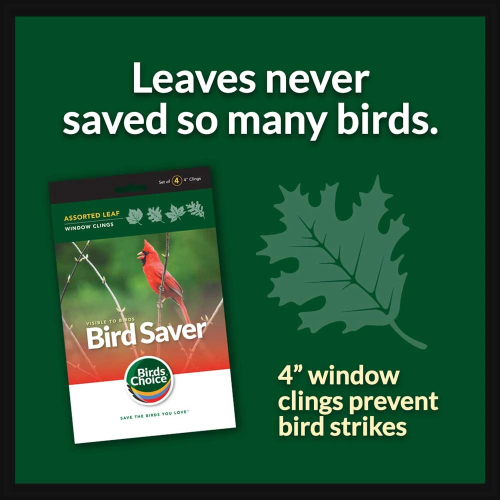Description
Protect the wild birds you love from window collisions!
Birding enthusiasts share a similar problem: wild birds fly from backyard trees and feeders into home windows where they are injured or die. Wild birds also collide with office windows. In North America alone, tens of millions of wild birds die in this manner each year.
Now you can help reduce this loss of life!
Solution: Bird Saver Window Clings are a high-tech decal that may be applied to home and office windows. Each cling is printed to brightly reflect ultraviolet light - something birds see vividly. Adding clings to your window is an easy way to help avoid bird strikes. This ultraviolet light is invisible to humans, but glows like a stoplight for birds.
Bird Saver Window Cling decals are four inches wide and are static-cling. They easily attach and peel off window glass. Made in the USA!
4" Decals available in attractive designs - Assorted Leaf, Butterfly, Hummingbird, or Snowflake
Features:
* Set of 32 Bird Saver Window Cling Decals - Assorted Leaf
* Apply to a clean exterior surface
* Best applied when glass is warmer than 50 degrees Fahrenheit
* Space clings 2" to 4" apart
* Replace every 4-6 months
Bird Saver Window Cling Decal 32-Pack comes as eight envelopes (same design). All designs have 4 decals per envelope, 32 decals total.


INSTRUCTIONS
1. Bird Saver Window Cling decals may be used only on an exterior glass surface -- free of any overlay, tinting, film, or coating. (Most modern glass does not have coatings on the exterior; any coatings are safely located between double-panes. Contact your local glass contractor for confirmation.)
2. Clean glass first with water. Avoid use of chemicals such as ammonia or window cleaners.
3. Decals are best applied when glass is warm (ideally, above 50 degress Fahrenheit). If applied during winter months, clean glass with warm water prior to application.
4. Place decals alone or in groups every 2-3 square feet on the window (the more decals the better). The greatest concentration of decals should be at the CENTER of the window.
5. Position out of reach of infants and small children.
6. Restore static cling by rinsing decal in lukewarm water.
7. The UV coating will fade over time based on exposure and local elevation. For this reason, replace decals every 1 to 2 years for maximum UV reflectivity.
DANGER ZONES
1) Bird strikes often occur when birds perceive a LINE OF FLIGHT through one window of your home and out another. This also occurs on buildings with corners made of glass. In these situations, position your decals to block a bird’s perceived line of flight.
2) Bird strikes may occur when birds see OPEN SKY reflected in your window. This may occur on certain windows or areas of a window based on the time of day or orientation to the sun. Use your decals to break up this reflection of open sky.
3) Bird strikes are often a problem near BIRD FEEDERS. Bird feeders should be positioned closer than 3 feet or farther than 30 feet from your windows. Feeding birds are often frightened and when they are, they take wild, evasive flight. If your feeder is close to the window, birds fly away from the house. If they do happen to strike a window, they may not have reached full speed and may survive. Believe it or not, the safest feeders are window feeders which attach to the window itself. You may find such feeders offered in our store.
4) Bird strikes are a problem with highly-reflective windows, windows near bodies of water, and windows near indoor mirrors. These situations may be difficult to remedy.
Facts About Bird Vision
Birds enjoy sharper vision than humans. Birds can see certain light frequencies--including ultraviolet--that humans cannot see.
In fact, many songbirds have feathers that reflect ultraviolet light. This light is used to communicate species, gender, and perhaps even social standing. Birds can see this ultraviolet light under normal, daylight conditions. Humans require the assistance of a black light.
Why do birds see better than humans?
1) Both birds and humans have photoreceptive 'cones' in the retina located at the back of the eye. These cones allow us to see color light. The human eye contains 10,000 cones per square millimeter. Songbirds, for example, have up to 12 times this amount or 120,000 cones per square millimeter.
2) In humans, these photoreceptive cones consist of three types. Each cone is sensitive to red, green, or blue light. This is called trichromatic color vision. Birds have an extra cone for quadchromatic color vision. This extra cone expands the visible light spectrum, allowing birds to see ultraviolet frequencies.
3) During low-light conditions, both humans and birds rely on photoreceptive ‘cell rods’ in the retina. The human eye has 200,000 cell rods per square millimeter. Some birds, such as owls, have up to 1,000,000 cell rods per square millimeter.
4) Bird eyes, on average, account for 15% of the mass of the bird’s entire head. Human eyes, by contrast, account for less than 2% of the head.
5) Bird retinas, in contrast to humans, contain no blood vessels. This prevents light scattering and thus provides birds with greater visual acuity than humans.
In sum, your favorite songbird will notice Bird Saver Window Cling decals the MOMENT you place them on your window!